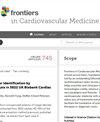病例报告:新型成像技术在下肢外周动脉疾病中的应用:近红外-II成像、OCTA和LSFG
IF 2.8
3区 医学
Q2 CARDIAC & CARDIOVASCULAR SYSTEMS
引用次数: 0
摘要
下肢外周动脉疾病(PAD)是一个日益严重的全球性健康问题。近年来,人们一直在探索诊断 PAD 的新方法。目前,针对 PAD 的成像方法大多集中在大血管血流方面,对 PAD 的微循环和组织灌注的探索仍显不足。在本报告中,我们在一名 PAD 患者身上应用了三种新的成像技术,即第二近红外区(NIR-II,900-1,880 nm 波长)成像、光学相干断层血管成像(OCTA)和激光斑点血流成像(LSFG),并以一名健康人作为对照。结果显示,PAD 患者的组织灌注比对照组差,但未观察到不良反应。此外,与第一个近红外区域(NIR-I,700-900 nm 波长)成像结果相比,NIR-II 成像比 NIR-I 成像具有更高的信噪比和分辨率,并能检测到 NIR-I 成像检测不到的微血管。这些观察结果表明,近红外-II成像、OCTA和LSFG是诊断PAD的潜在安全有效的方法。本文章由计算机程序翻译,如有差异,请以英文原文为准。
Case Report: The application of novel imaging technologies in lower extremity peripheral artery disease: NIR-II imaging, OCTA, and LSFG
Lower extremity peripheral artery disease (PAD) is a growing global health problem. New methods to diagnose PAD have been explored in recent years. At present, the majority of imaging methods for PAD focus on the macrovascular blood flow, and the exploration of microcirculation and tissue perfusion of PAD remains largely insufficient. In this report, we applied three new imaging technologies, i.e., second near-infrared region (NIR-II, 900–1,880 nm wavelengths) imaging, optical coherence tomography angiography (OCTA), and laser speckle flowgraphy (LSFG), in a PAD patient with a healthy human subject as control. Our results showed that the PAD patient had poorer tissue perfusion than the control without observed adverse effects. Moreover, compared with the first near-infrared region (NIR-I, 700–900 nm wavelengths) imaging results, NIR-II imaging had a higher signal-to-background ratio and resolution than NIR-I imaging and detected microvessels that were not detected by NIR-I imaging. These observations suggested that NIR-II imaging, OCTA, and LSFG are potentially safe and effective methods for diagnosing PAD.
求助全文
通过发布文献求助,成功后即可免费获取论文全文。
去求助
来源期刊

Frontiers in Cardiovascular Medicine
Medicine-Cardiology and Cardiovascular Medicine
CiteScore
3.80
自引率
11.10%
发文量
3529
审稿时长
14 weeks
期刊介绍:
Frontiers? Which frontiers? Where exactly are the frontiers of cardiovascular medicine? And who should be defining these frontiers?
At Frontiers in Cardiovascular Medicine we believe it is worth being curious to foresee and explore beyond the current frontiers. In other words, we would like, through the articles published by our community journal Frontiers in Cardiovascular Medicine, to anticipate the future of cardiovascular medicine, and thus better prevent cardiovascular disorders and improve therapeutic options and outcomes of our patients.
 求助内容:
求助内容: 应助结果提醒方式:
应助结果提醒方式:


